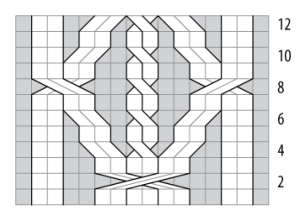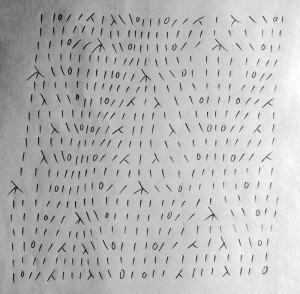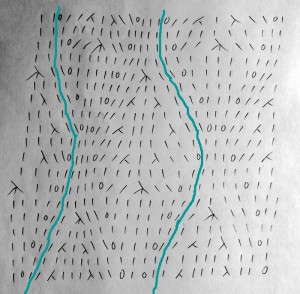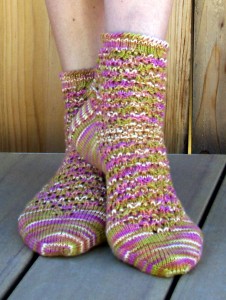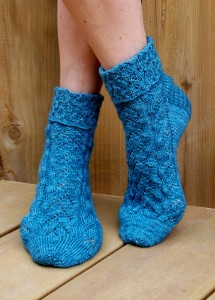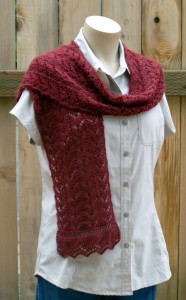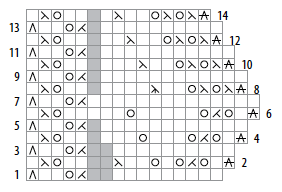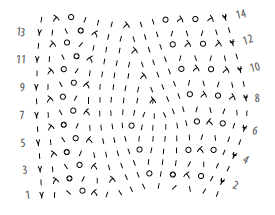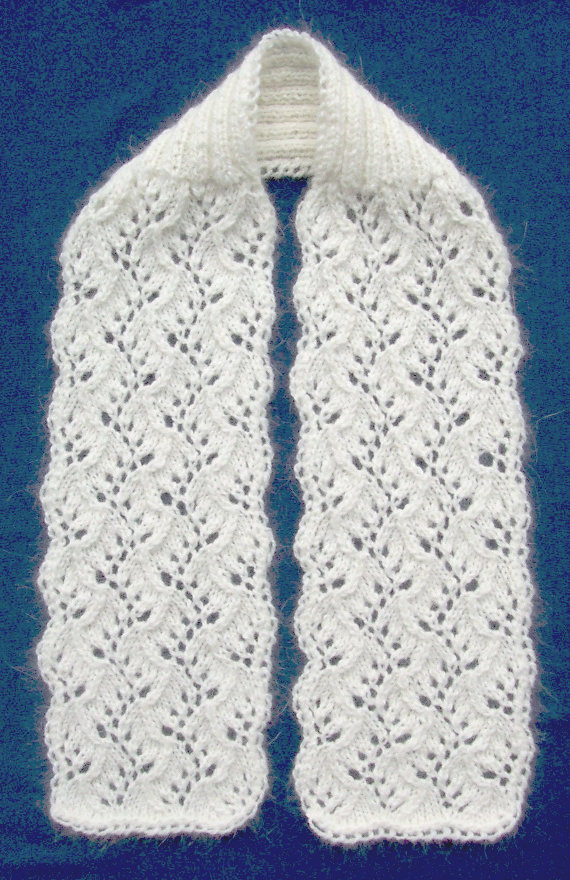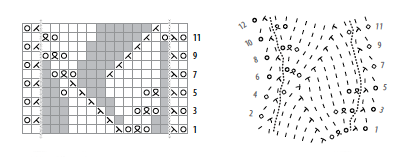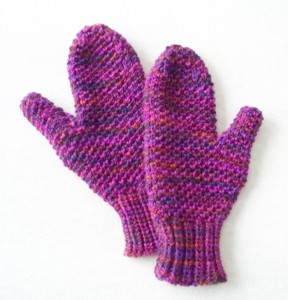Musings
By JC | August 14, 2014
Don’t get me wrong. The grand majority of the time, I think that cabled stitch patterns, like knit/purl patterns, are best charted using traditional grid-based charts. The grid provides structure, making it possible to choose symbols that clearly represent the fabric with a minimum of clutter.
But I still want to support cables at Stitch-Maps.com. You have Estonian lace patterns that feature the occasional cable cross. And you have “Celtic” (or “continuous”) cables, with increases at the base and decreases at the top of each cabled loop. These sorts of patterns would display nicely as stitch maps.
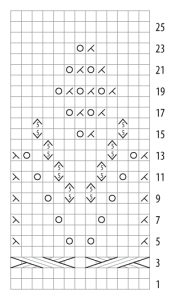
with a stitch map, you could see how the lace flows;
stitch pattern courtesy Nancy Bush’s Knitted Lace of Estonia
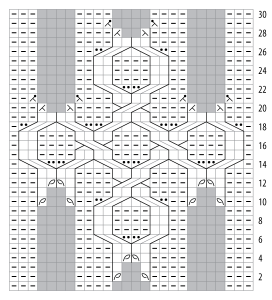
with a stitch map, you wouldn’t have any “no stitch” symbols;
stitch pattern courtesy Elsebeth Lavold’s Viking Patterns for Knitting
So that’s why I’ve been working recently on adding support for cable crosses. I’ve been figuring out what abbreviations to recognize, how to draw the symbols, and where to draw the line and say, “That’s enough cable cross symbols. It’s time to work on something else now.” And though I’m normally reluctant to talk about works in progress, I’ve made some interesting observations that fellow knitting geeks might appreciate. I’ll post my musings over the next few days. Stay tuned!
In case you hadn’t noticed, I’m a bit obsessed with stitch patterns. So it’s no surprise that, as I’m flipping through Textured Stitches by Connie Chang Chinchio, part of me is oohing and aahing over the lovely garments, but a bigger part of me is drooling over the stitch patterns.
Case in point: the lace pattern in the Starflower Hat. Was it the same as the Falling Leaves pattern I’d recently found in Vogue Stitchionary Volume Five?
Alas, it was hard to tell from the photos in Textured Stitches. And the instructions were written, not charted.
No problem. I popped over to Stitch-Maps.com and entered in those written instructions.
Whoops. Things were clearly off-kilter. Symbols weren’t lining up as you’d expect; the centers of the motifs were gradually drifting to the right.
A quick check revealed that errata had been published for the pattern. (No worries. These things happen.) The book should’ve instructed the knitter to move the beginning-of-rounds marker at the start of rounds 7 and 15.
Now, Stitch-Maps.com doesn’t understand the concept of “markers,” much less “remove marker, k1, replace marker.” But I wanted to see what the stitch pattern looked like as a stitch map, so I fiddled around on paper for a bit. (Yes, I still draw stitch maps by hand, when I’m trying to figure things out. Once the “ah ha!” moment has been reached, I can always draw a pretty stitch map at Stitch-Maps.com.) Following the stitch map, but properly lining up the symbols from one row to the next, this is what I got:
Notice how the motifs widen and narrow. With two motifs side by side, offset vertically by a half a repeat, you can draw lines at “natural breaks” within the stitch pattern:
And voilà! Entering those instructions into Stitch-Maps.com gave me the stitch map I wanted:
The nifty thing about this stitch map is that it can be followed in the round without ever having to move the beginning-of-rounds marker. Gaining that kind of insight into a stitch pattern is why I love stitch maps so much.
But back to the original question: how does Starflower compare with Falling Leaves? That’s easiest to answer when comparing apples to apples, so straigtening Starflower’s edges so it can be worked as an insertion (flat or in the round), we see this:
Mm… nope. The two patterns are quite similar, but they’re not quite the same. Guess I’m going to need to swatch both of them.
Two-fer
By JC | March 27, 2014
Remember how I said I was going to update my patterns to include stitch maps? Yeah, that project fell by the wayside. (Too many projects! Too little time!)
Today, though, I present to you a two-fer: two sock patterns updated to use stitch maps in addition to traditional charts and written instructions. First up, Corrine:
And Yachats:
Both are anklets. (I have become unreasonably fond of anklets lately. Or is it really unreasonable? Anklets stay in place! You never have to tug up on drooping legs!) But they differ in their use of stitch maps. Corrine has just one simple stitch map:

Clematis, from A Compendium of Knitted Stitch Patterns by Shelagh Hollingworth
This makes the Corrine pattern an easy introduction to stitch maps.
Yachats has a couple beefier stitch maps, including one of my favorites, Rivulets:
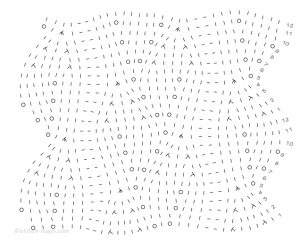
Rivulets, a variation on Vine Stripe by Barbara Walker
With Rivulets (and the Little Waves pattern on the cuff), Yachats makes fabulous use of stitch maps. It’s a pattern you can sink your teeth into. No, wait, I have a better metaphor: It’s a pattern that lets you give stitch maps a serious test drive, see how they compare to traditional charts, and wonder how you ever used to knit lace without them.
Yeah, okay, so I’m a little passionate about stitch maps. You’re not surprised, are you? 🙂
Long-time readers of this blog will remember Jolie, a lace scarf knit in Berroco Ultra Alpaca Fine.
Ditto my rantings on how its edging should be charted.
Of course, those rantings pre-dated Stitch-Maps.com. Don’t you just love the stitch map for the edging? No “no stitch” symbols, and a clear understanding of how the parts of the stitch pattern fit together.
And so that’s why I’m re-releasing the pattern for Jolie. It now includes stitch maps for all its stitch patterns… and traditional grid-based charts, and written instructions, for those of you looking for some training wheels.
Enjoy!
Traveling
By JC | November 5, 2013
Next up in the series of patterns updated to include stitch maps is the Traveling Vines scarf.
I don’t know what I like most about this scarf: its yarn, Windsor Farms Rabbitry Angora Blizzard, or its stitch pattern, Traveling Vines.
Way nicer as a stitch map, don’t you think?
Speaking of traveling… tomorrow I’m headed to Stitches East. Hope to see you there!
Updated
By JC | October 29, 2013
You know those Sidewinder socks I posted about yesterday? The pattern has been available for almost two years, but now it features a little facelift:
That’s right, traditional grid-based charts and grid-free stitch maps, side by side. (And written instructions, for those of you that haven’t yet jumped on the chart bandwagon.) You can follow whichever set of instructions turns your crank, or – and here’s the fun part – you can click on hotlinks within the pattern PDF to view the stitch maps interactively at Stitch-Maps.com.
I figured it was high time I started using stitch maps in my own patterns. And with its sinuous nature, Sidewinder was the perfect place to start. More updated patterns will follow, as I find the time. I’ll post about them here, and on the Stitch Maps group on Ravelry.
Lately it seems I get most of my knitting done while traveling. Case in point:
Before Stitches Midwest, knowing that I would need some travel knitting, I cast on these Sidewinder socks. I don’t often knit one of my own designs twice, so this was a treat: No need to scour stitch dictionaries for ideas! No need to plan the cuff treatment, or the heel shaping! Just knit!
And the knitting was fun. I used Frog Tree Pediboo, an 80/20 blend of wool and bamboo. It behaved beautifully during the knitting, with no splitting, knots, or other complaints. And you can see the stitch definition is fabulous. I look forward to seeing how the socks hold up over time.
But fast? Nuh uh. This was travel knitting, remember? I snuck in a few rounds on my trip to the Knitting Bridge guild in September, but otherwise the project languished until I headed to New York State earlier this month. Ah, nothing like a 2.5-week trip to make a dent in the travel knitting! I even managed to get started on my next travel-knitting project:
Yup, more toe socks, once again in Blue Moon Fiber Arts Silkie Socks that Rock. The first sock knit up in a hurry, and the second sock is already past the fussy stage: the toes have been knit and joined together, and the junctures between the toes have been grafted. In other words, this project is at the perfect point for hours of mindless travel knitting. I plan to exercise great restraint, and leave the project aside until I head to Stitches East next week.
Collecting
By JC | October 20, 2013
Yesterday I visited Rhinebeck for the first time, and what did I do? Buy fiber and yarn? Nope, I don’t spin, and my yarn stash overfloweth already. Instead, I did a little collecting:
Some people collect stamps, or butterflies. Me, I collect stitch patterns. These I found “in the wild,” on samples hanging in vendor booths at Rhinebeck. Pretty, yes?
As for Rhinebeck, it was just as incredible as I’d always heard. Getting to wander through building after building of vendor booths, and to meet up with people I don’t see often enough, was fabulous. The glorious weather was a huge bonus. Will I come back? I’m almost tempted to say no, this weekend was perfect, it couldn’t have been better.
Inspired
By JC | September 10, 2013
Last weekend’s test-run of my new Wedge Shawl Design class went quite well, if I do say so myself. Oh, sure, there was a hiccup or two, and you know I’ll be making improvements to the class based on the feedback I got.
But what blew me away was how inspired the students were. Several spent the rest of the weekend knitting away on shawls of their own design; I loved seeing the progress they made. Others chafed at the chance to get home, pull some special yarn out of their stash, and get started.
Yes. That’s what the class was supposed to do.
Me, I resisted the urge to start another shawl myself. Instead, I whipped up a pair of mittens:
They’re all brioche: Half Brioche for the cuff, and Fluffy Brioche for the rest. Soon, they’ll be a surprise gift for a very special person. Ssh, don’t tell her…
Did you take some time off this holiday weekend? I did. It was fabulous.
But now it’s back to work, and oh, my. If I think too much about my upcoming schedule, I start hyperventilating:
- This weekend I head to small, local retreat where I get to test-teach a new class to a bunch of friends. (A friendly audience is always good for kicking off a new class.) I’m excited by the topic, Wedge Shawl Design. I have samples, and I know how I want the class to run. I just need to finish writing the handouts… eep!
- A short two weeks later, I head to the Bay area to teach Charts Made Simple and Lace Basics to the Knitting Bridge guild, and Charts Made Essential and Manage Those Numbers! for A Verb for Keeping Warm. Should be fun! I always like visiting the Bay area, and I’m excited to visit Verb for the first time.
- October features a mega-trip: four days(!) teaching for the Rochester Knitting Guild, two for the Knitting Guild of Greater Buffalo, and then a side trip to Rhinebeck. Goodness. I have no idea how I’m going to pack everything I’ll need.
- November brings Stitches East… always a good time. And, tentatively scheduled, a webinar hosted by Interweave. More news on that later.
I’d call that a rather full schedule; wouldn’t you? Wish me luck! I gotta get back to writing those handouts…



